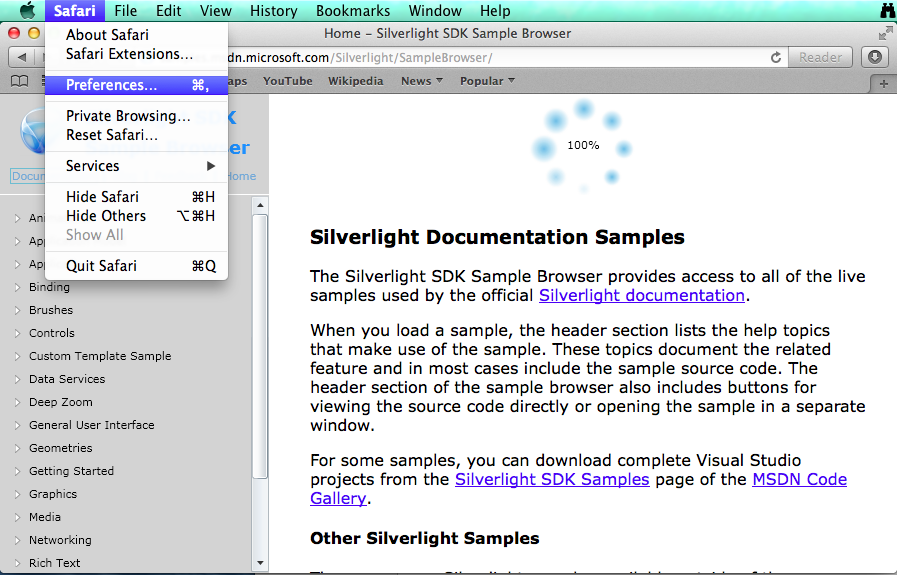Safari extensions add functionality to Safari, so you can explore the web the way you want. Extensions can show helpful information about a webpage, display news headlines, help you use your favorite services, change the appearance of webpages, and much more. Extensions are a great way to personalize your browsing experience.
Check Safari/Preferences/Security and check that Allow Plug-ins is checked. Then click Plug-in Settings and see if Silverlight is checked. RECOMMENDED: Use Silverlight in the 32-bit Internet Explorer process on x64 systems. Most browser plug-ins (including Silverlight, Flash, Java and almost all ActiveX controls) only work in 32-bit browsers currently. Locate the 'Install Silverlight' area in the lower-right part of the window. If you are running an Intel processor, click Mac Runtime next to 'Silverlight 3.' Otherwise, click Runtime for Mac PowerPC next to 'Silverlight 1.0.' After the download is completed, installation should start automatically. Check if the Silverlight Plugin is enabled. From your Safari menu bar click Safari Preferences then select the Security tab. Now click Website Settings to the right of: Internet plug-ins; Select Silverlight on the left then select Allow or Ask from the: When visitng other websites pop up menu on the right.
Use the App Store to conveniently download and install Safari extensions. All extensions in the App Store are reviewed, signed, and hosted by Apple for your security.
How to install extensions
Silverlight Plugin Safari Chrome
Start by installing the latest macOS updates to make sure that Safari is up to date. You need Safari 12 or later to get Safari extensions from the App Store.
Find and install an extension:
- Open Safari and choose Safari > Safari Extensions from the menu bar.
- The App Store opens to the Safari Extensions page, as pictured above. To download and install an extension, click Get or click the price. You might be asked to sign in with your Apple ID.
- Click Install.
- After the extension is installed, click Open and follow the onscreen instructions provided by the extension.
Then return to Safari to turn on the extension you installed:
- Choose Safari > Preferences.
- Click Extensions.
- Select the checkbox next to the extension's name.
All extensions installed from the App Store are automatically kept up to date.
How to turn off or uninstall extensions
Choose Safari > Preferences, then click Extensions.
- To turn off an extension, deselect its checkbox.
- To uninstall an extension, select the extension and click the Uninstall button. If you can't determine what an extension does, or you don't expect to use it again, you should uninstall it.
Learn more
Safari no longer supports most web plug-ins. To load webpages more quickly, save energy, and strengthen security, Safari is optimized for content that uses the HTML5 web standard, which doesn't require a plug-in. To enhance and customize your browsing experience, use Safari extensions instead of web plug-ins.
After I installed Safari for Windows, the second thing I did was see if it would run Silverlight. I loaded up the Airline sample that I had running locally on my machine and got this.
From this I glean that the JavaScript detection code isn't digging Safari on Windows. So...checking my HTTP UserAgent gives me:
...but on Mac it's usually:
...and since it's not Silverlight but rather the JavaScript that makes the decision on whether to try to load Silverlight (and considering that Flash and what-not worked in Safari without be needing to reinstall any plugins).
I opened up this app's Silverlight.js file and added an alert() around line 85:
var versionStr = detectAgControlVersion();
alert(versionStr);
...and it reported 0.8.5. That means that Safari can see the plugin on the system, but the version should be 0.95.
I figure that the Silverlight Team is already all over this, so rather than solving the problem for them, I added:
agVersion = '0.95.0';
...around line 65 to force the issue. This got Silverlight loaded into memory, as seen in the Process Explorer screenshot below...
Silverlight Plugin Safari Ipad
...but nothing showed up. Blank screen. No amount of windows jiggling or resizing (to force a paint) would get it going on my system.
Silverlight Plugin Safari 13
UPDATE: Tim Heuer tried the same thing and says the Silverlight Team is on it and that Safari smells like Opera to Silverlight. He also says he was able to get a control to show while I was not.
If this browser is going to get some share (and it likely will with 1 million iTunes downloads a month - they'll likely bundle it virally) then Silverlight support is a must.
About Scott
Scott Hanselman is a former professor, former Chief Architect in finance, now speaker, consultant, father, diabetic, and Microsoft employee. He is a failed stand-up comic, a cornrower, and a book author.
Silverlight Plugin Safari Mac
AboutNewsletter

